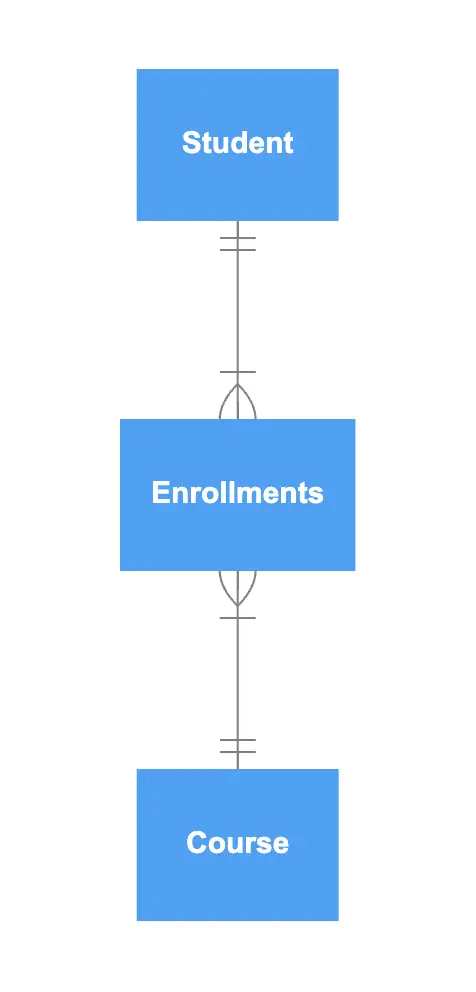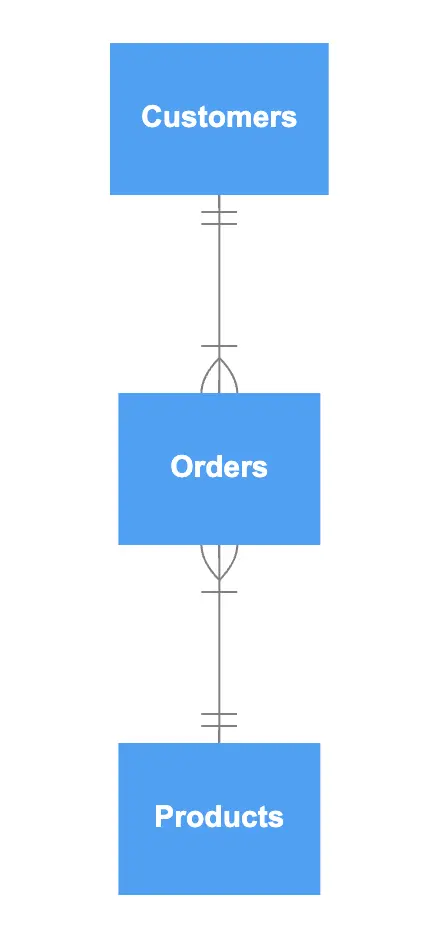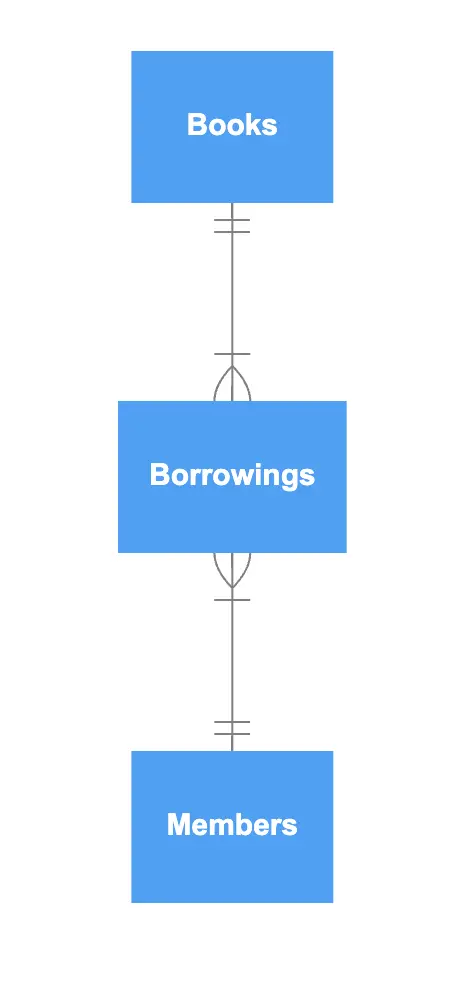Entity-relationship diagrams (ERDs) are fundamental tools used in database design to visually represent the structure of a database. They illustrate entities—such as objects, people, concepts, or events—and the relationships between them, providing a clear and organized framework for how data is interconnected within the system.
One important element within ERDs is the associative entity, a specialized type of entity that plays a critical role in managing many-to-many relationships between other entities.
Understanding Associative Entities in ER Diagrams
Associative entities help simplify complex relationships by breaking them down into more manageable one-to-many relationships. This not only normalizes the database but also helps eliminate redundancy, ensuring data consistency and integrity.
Make your own ER diagram in Gleek.
By understanding and utilizing associative entities, database designers can create more efficient, organized, and maintainable relational databases. In the following subsection, we will explore the definition and characteristics of an associative entity within an ERD.
What is an Associative Entity in an ERD?
An associative entity, also known as a junction table or bridge table, is a specialized entity within an ERD used to represent many-to-many relationships between two other entities. In relational database design, many-to-many relationships can be complex and challenging to manage directly. Associative entities simplify these relationships by breaking them down into two one-to-many relationships.
An associative entity connects two entities that have multiple interactions with each other. It contains foreign keys that reference the primary keys of the two entities it links, thereby acting as a conduit for their relationship. This approach not only simplifies the database structure but also aids in normalization—reducing redundancy and ensuring data integrity.
Related topic: Primary keys vs Foreign keys
By incorporating associative entities, database designers can create relational databases that are efficient, normalized, and maintain data integrity. As we move forward, the next section will guide you on how to identify associative entities within an ERD, providing practical insights and techniques.
How do you find the Associative Entity?
Identifying associative entities within an ERD requires a keen eye for relationships between entities and a solid understanding of database design principles. Here’s a step-by-step guide to help you recognize associative entities in your diagrams:
Identify Many-to-Many Relationships:
Start by scanning your ERD for many-to-many relationships. These are typically represented by a connector line between two entities with a "crow's foot" notation on both ends.
Example:
StudentsandCourses.
Student{1}--{1..n}Enrollments{1..n}--{1}Course
Look for Intermediate Entities:
Check if there is an intermediate entity that links the two main entities involved in the many-to-many relationship. This entity often contains foreign keys referencing the primary keys of both main entities.
Example: An
Enrollmentstable linkingStudentsandCourses.
Analyze Attribute Composition:
Verify that the intermediate entity includes attributes that serve as foreign keys from the related entities.
Example:
Enrollmentsshould haveStudentIDandCourseID.
Check for Relationship Simplification:
Ensure that the intermediate entity simplifies the many-to-many relationship into manageable one-to-many relationships with each of the original entities.
Example:
Students -> EnrollmentsandCourses -> Enrollments.
Confirm Database Normalization:
Assess whether the inclusion of the associative entity helps in normalizing the database by reducing redundancy and maintaining data integrity.
Example: Each enrollment record uniquely represents a student's participation in a course.
Make your own ER diagram in Gleek.
Visual Cues in Gleek App:
In Gleek, associative entities are represented using specific notations and symbols that make it easy to visualize complex relationships. Associative entities help break down many-to-many relationships into simpler one-to-many relationships.
Practical example in Gleek app notation:
Consider the following ERD snippet in Gleek notation:
Student{1}--{1..n}Enrollments{1..n}--{1}Course

Entities:
Student: Represents the students.Course: Represents the courses.
Associative Entity:
Enrollments: Represents the association between students and courses.
Breakdown of the Notation:
Student{1}: Each student can have one or more enrollments.
{1..n}Enrollments: The associative entity Enrollments connects students and courses.
{1..n} indicates that each student can have one or more enrollments, and each course can have one or more enrollments.
{1}Course: Each course can have one or more enrollments.
By following these steps and using tools like the Gleek app, you can confidently identify associative entities in your ERDs, ensuring your database design is robust, normalized, and easy to maintain.
What is the Difference Between Associative and Transactional Entities?
In database design, differentiating between associative and transactional entities is essential for creating a functional and efficient database. While we've already covered associative entities in detail, this section will clarify how they differ from transactional entities, emphasizing their distinct roles and contributions to the overall database structure.
Transactional Entities
Transactional entities capture dynamic, time-bound activities or events within a database. These entities are essential for documenting business processes and providing a detailed log of operations.
Purpose: The primary function of transactional entities is to record specific events or transactions occurring within the system. They are essential for tracking real-time business activities, such as sales, orders, or financial transactions.
Attributes: Transactional entities typically contain detailed information about each transaction. This includes attributes like timestamps, quantities, prices, and other relevant details that describe the event comprehensively.
Example: In an e-commerce database, an
Ordersentity records customer purchases. It includes attributes such asOrderID,CustomerID,ProductID,OrderDate,Quantity, andTotalAmount.
Make your own ER diagram in Gleek.
Key Differences
Role and Functionality: Associative entities manage many-to-many relationships between entities, ensuring normalization and data integrity. Transactional entities, on the other hand, capture and document specific business transactions.
Attributes: Associative entities generally consist of foreign keys and may include additional attributes describing the relationship between entities. In contrast, transactional entities are detailed records of transactions, with numerous attributes describing the specifics of each event.
Data Dynamics: Associative entities are relatively stable, changing mainly when relationships between entities are updated. Transactional entities are dynamic, continuously updated with new transactions that reflect ongoing business operations.
Rules and Best Practices for Associative Entities
Implementing associative entities effectively in ERDs requires adherence to certain guidelines and best practices. This section provides the essential rules and recommendations to help you design and use associative entities efficiently in your database.
What are the Rules for Associative Entities?
When creating and using associative entities, several key rules should be followed to maintain a well-structured and normalized database:
1.Naming Conventions:
Descriptive Names: Use clear and descriptive names for associative entities that reflect the relationship they manage. For instance, in a university database, an associative entity linking Students and Courses could be named Enrollments.
Consistency: Maintain consistent naming conventions throughout your ERD to avoid confusion and ensure clarity.
2.Relationship Definitions:
Foreign Keys: Ensure that the associative entity contains foreign keys that reference the primary keys of the entities it links. These foreign keys establish the connections and enforce referential integrity.
Cardinality: Define the cardinality of the relationships clearly. Associative entities typically convert many-to-many relationships into two one-to-many relationships.
Read on how to represent multiplicity in Er diagrams.
3.Attributes:
Primary Key: The associative entity should have a composite primary key comprising the foreign keys from the linked entities. This ensures that each relationship instance is unique.
Additional Attributes: Include any additional attributes that describe the relationship. For example, an Enrollments entity might include an EnrollmentDate attribute.
4.Constraints:
Referential Integrity: Enforce referential integrity by ensuring that the foreign keys in the associative entity always reference valid entries in the linked entities.
Uniqueness: Ensure that the combination of foreign keys in the associative entity is unique to prevent duplicate relationship entries.
Examples of an Associative Entity
Providing concrete examples can help solidify the theoretical knowledge of associative entities. Here are a few practical instances across different contexts:
Entities Involved: Customers and Products
Associative Entity: Orders
Attributes: CustomerID (foreign key), ProductID (foreign key), OrderDate, Quantity
Relationships:
Customers{1}--{1..n}Orders{1..n}--{1}Products

Entities Involved: Books and Members
Associative Entity: Borrowings
Attributes: BookID (foreign key), MemberID (foreign key), BorrowDate, ReturnDate
Relationships:
Books{1}--{1..n}Borrowings{1..n}--{1}Members

Associative entities play a crucial role in Entity-Relationship diagrams, helping to simplify and manage complex many-to-many relationships within a database. By understanding how to identify and implement these entities, you can ensure your database is both normalized and efficient.
Make your own ER diagram in Gleek.
Incorporating best practices when designing associative entities—such as using clear naming conventions, defining relationships accurately, and maintaining referential integrity—further enhances the strength of your database structure.
To apply these concepts and streamline your database design process, try out Gleek, an intuitive app for creating entity-relationship diagrams. With Gleek, you can visualize and manage complex relationships easily, putting into practice the techniques and guidelines discussed.
Embrace the power of associative entities and tools like Gleek, elevate your database design skills and create more effective, maintainable systems.
Related posts
ER diagram example: online shopping system (Crow’s Foot notation)
All about ER model cardinality with examples
Relational schema vs. ER diagrams: A detailed comparison
ER diagram for an E-commerce website with Gleek's AI chat
Guide to entity-relationship diagram notations & symbols
The Basics of One-to-One Relationships in ERD
How do you convert an ER diagram into a relational schema?
What is the entity-relationship diagram in database design?
Crow’s foot notation in entity-relationship diagrams
Crow’s Foot vs. Chen notation: detailed comparison for 2024
Enhanced entity-relationship diagram: features and components
